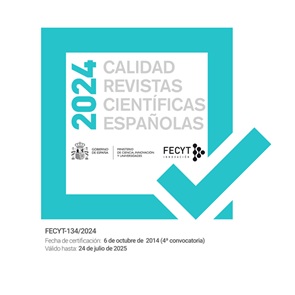Filosofía de la danza: Cuerpo y expresión simbólica
Agencias de apoyo
- MINECO FFI2014-53926-R
- FFI2015-67569-C2-2-P
Resumen
La filosofía de la danza se define como el estudio sobre un cierto tipo de arte no-representativo que a través del movimiento del cuerpo alcanza efectos estéticos. Desde la aproximación de las ciencias cognitivas se desmiente esta presuposición original de la danza como arte no-representativo. Se introducen, brevemente, varias razones para ver la filosofía de la danza desde el enfoque naturalista de las ciencias cognitivas donde el cuerpo tiene capacidad de expresión simbólica.
Descargas
-
Resumen2402
-
PDF9246
Citas
Bresnahan A. (2015), “The Philosophy of Dance” en E. Zalta (ed) The Stanford Encyclopedia of Philosophy. Publicado el 12 de enero del 2015. Disponible en: http://plato.stanford.edu/entries/dance/
Brownlow S., Dixon A., Egbert C. y Radcliffe R. (1997), “Perception of movement and dancer characteritics from point light displays of dance”. Psychol. Rec. No. 47, pp. 411-421.
Calvo-Merino B., Glaser D., Grezes J., Passingham R. y Haggard P. (2005), “Action observation and acquired motor skills: An fMRI study with expert dancers”. Cerebral Cortex, No. 15, pp. 1905-1910.
Carroll N, (2004), “Mass art as art: A response to John Fisher”. Journal of Aesthetics and Art Criticism, No. 62, pp. 61-65.
Christensen J, Nadal M., Cela-Conde C. y Gomila T. (2014), “A norming study and library of 203 dance movements”. Perception, No. 43, pp. 178-206.
Clark A. y Chalmers D. (1998), “The extended mind”. Analysis, No. 58, pp. 7-19.
Cross E., Kirsch L., Ticini L. y Schütz-Bosbach S. (2014), “The impact of aesthetic evaluation and physical ability on dance perception”, Front. Hum. Neurosci. No 8, pp. 102.
Fadiga L. et al. (1995), “Motor facilitation during action observation: a magnetic stimulation study”. J. Neurophysiol, No. 73, pp. 2608-2611.
Freedberg D. y Gallese V. (2007), “Motion, emotion and empathy in esthetic experience”. Trends Cogn. Sci., No. 8, pp. 396-403.
Gallese V., Fadiga L., Fogassi L. y Rizzolatti G. (1996), “Action recognition in the premotor cortex”. Brain, No. 119, pp. 593-609.
Gallese V. y Cuccio V. (2015), “The paradigmatic body: Embodied simulation, intersubjetivity and the bodily self”. En T. Metzinger y J. Windt (eds), Open Mind, 1-27. Frankfurt: MIND Group.
Hagendoorn I. (2011), “Dance, choreography and the brain” en D. Melcher y F. Bacci (eds) Art and the Senses. Oxford: Oxford University Press.
Johansson G. (1973), “Visual perception of biological motion and a model for its analysis”. Perception and Psychophysics. N. 14, pp. 201-211.
Kandel E. (2016), Reductionism in Art and Brain Science: Bridging the Two Cultures. New York: Columbia University Press.
Kozlowski L. y Cutting J. (1977), “Recognizing the sex of a walker from a dynamic point-light display”. Perception and Psychophysics. No. 21, pp. 575-580.
Meltzoff A. (2013), “Origins of social cognition: Bidirectional self-other mapping and the like-me hypothesis” en M. Banaji y S. Gelman (eds), Navigating the Social World: What Infants, Children and Other Species Can Teach Us. New York: Oxford University Press.
Rizzolatti G., Fadiga L. Gallesse V. y Fogassi L. (1996a), “Premotor cortex and the recognition of actions”. Cogn. Brain Res, No. 3, pp. 131-141.
Rizzolatti G. and Craighero L. (2004), “The Mirror Neuron System”. Annual Rev. Neurosci, No. 27, pp. 169.192
Tarr B., Launay J., Cohen E y Dunbar R. (2015), “Synchrony and exertion during dance independently raise pain threshold and encourage social bonding”. Biology Letters, No. 11, pp. 20150767.
Verghese J. et al (2003), “Leisure Activities and the Risk of Dementia in the Elderly”. N. Engl. J. Med. No. 348, pp. 2508-2516.
Zeki S. (2009), Splendors and Miseries of the Brain: Love, Creativity, and the Quest for Human Happiness. Sussex: Wiley-Blackwell
Las obras que se publican en esta revista están sujetas a los siguientes términos:
1. El Servicio de Publicaciones de la Universidad de Murcia (la editorial) conserva los derechos patrimoniales (copyright) de las obras publicadas, y favorece y permite la reutilización de las mismas bajo la licencia de uso indicada en el punto 2.
2. Las obras se publican en la edición electrónica de la revista bajo una licencia Creative Commons Reconocimiento-NoComercial-SinObraDerivada 3.0 España (texto legal). Se pueden copiar, usar, difundir, transmitir y exponer públicamente, siempre que: i) se cite la autoría y la fuente original de su publicación (revista, editorial y URL de la obra); ii) no se usen para fines comerciales; iii) si remezcla, transforma o crea a partir del material, no podrá distribuir el material modificado.
3. Condiciones de auto-archivo. Se permite y se anima a los autores a difundir electrónicamente las versiones pre-print (versión antes de ser evaluada) y/o post-print (versión evaluada y aceptada para su publicación) de sus obras antes de su publicación, ya que favorece su circulación y difusión más temprana y con ello un posible aumento en su citación y alcance entre la comunidad académica. Color RoMEO: verde.










